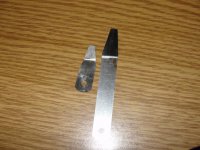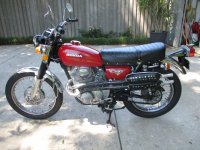davidevoss
Veteran Member
You probably thought you were through with me for a while but I need some advice. I have a newly refreshed engine on my 1972 CL350 - new rings, new valves (lapped in by me), new cam chain, new cam chain roller and rubber, new gaskets, new seals and most recently new carburetor boot gaskets installed with Hondabond (on both sides of gaskets). While I was doing the carb boot gaskets I took the opportunity to readjust the cam chain tensioner and readjust the valve gap to a snug 0.002 and 0.004 gap all according to the FSM.
Here's the problem - I'm an old guy and I wear hearing aids and they are extremely sensitive to certain noises - especially high pitch metallic sounds. With my hearing aids off the engine sounds pretty quiet and tight with a little valve "tapping" similar to what I experience with the mid-60s push rod Hondas I have rebuilt. However, with my hearing aids on - and with videos taken with my I-Phone the engine sounds extremely loud - like the valve are way off or the timing chain is slapping. Therefore, I have taken a video with sound of the engine at idle and would like someone with younger and better ears to let me know if this engine is alright or not.
Probably a pretty weird request but thanks in advance for listening.
Here is the YouTube link to the video:
David Voss
Here's the problem - I'm an old guy and I wear hearing aids and they are extremely sensitive to certain noises - especially high pitch metallic sounds. With my hearing aids off the engine sounds pretty quiet and tight with a little valve "tapping" similar to what I experience with the mid-60s push rod Hondas I have rebuilt. However, with my hearing aids on - and with videos taken with my I-Phone the engine sounds extremely loud - like the valve are way off or the timing chain is slapping. Therefore, I have taken a video with sound of the engine at idle and would like someone with younger and better ears to let me know if this engine is alright or not.
Probably a pretty weird request but thanks in advance for listening.
Here is the YouTube link to the video:
David Voss



